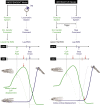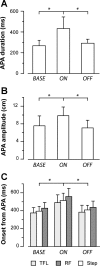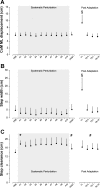Postural dependence of human locomotion during gait initiation
- PMID: 25231611
- PMCID: PMC4269713
- DOI: 10.1152/jn.00436.2014
Postural dependence of human locomotion during gait initiation
Abstract
The initiation of human walking involves postural motor actions for body orientation and balance stabilization that must be effectively integrated with locomotion to allow safe and efficient transport. Our ability to coordinately adapt these functions to environmental or bodily changes through error-based motor learning is essential to effective performance. Predictive compensations for postural perturbations through anticipatory postural adjustments (APAs) that stabilize mediolateral (ML) standing balance normally precede and accompany stepping. The temporal sequencing between these events may involve neural processes that suppress stepping until the expected stability conditions are achieved. If so, then an unexpected perturbation that disrupts the ML APAs should delay locomotion. This study investigated how the central nervous system (CNS) adapts posture and locomotion to perturbations of ML standing balance. Healthy human adults initiated locomotion while a resistance force was applied at the pelvis to perturb posture. In experiment 1, using random perturbations, step onset timing was delayed relative to the APA onset indicating that locomotion was withheld until expected stability conditions occurred. Furthermore, stepping parameters were adapted with the APAs indicating that motor prediction of the consequences of the postural changes likely modified the step motor command. In experiment 2, repetitive postural perturbations induced sustained locomotor aftereffects in some parameters (i.e., step height), immediate but rapidly readapted aftereffects in others, or had no aftereffects. These results indicated both rapid but transient reactive adaptations in the posture and gait assembly and more durable practice-dependent changes suggesting feedforward adaptation of locomotion in response to the prevailing postural conditions.
Keywords: balance; coordination; locomotion; motor adaptation; posture.
Copyright © 2014 the American Physiological Society.
Figures






Similar articles
-
"Posture first": Interaction between posture and locomotion in people with low back pain during unexpectedly cued modification of gait initiation motor command.Hum Mov Sci. 2023 Jun;89:103094. doi: 10.1016/j.humov.2023.103094. Epub 2023 May 4. Hum Mov Sci. 2023. PMID: 37148816
-
Perturbations of ground support alter posture and locomotion coupling during step initiation in Parkinson's disease.Exp Brain Res. 2011 Feb;208(4):557-67. doi: 10.1007/s00221-010-2504-z. Epub 2010 Dec 12. Exp Brain Res. 2011. PMID: 21153725
-
Age differences in anticipatory and executory mechanisms of gait initiation following unexpected balance perturbations.Eur J Appl Physiol. 2021 Feb;121(2):465-478. doi: 10.1007/s00421-020-04531-1. Epub 2020 Oct 26. Eur J Appl Physiol. 2021. PMID: 33106932 Free PMC article.
-
Development of postural control in healthy children: a functional approach.Neural Plast. 2005;12(2-3):109-18; discussion 263-72. doi: 10.1155/NP.2005.109. Neural Plast. 2005. PMID: 16097479 Free PMC article. Review.
-
Anticipatory and compensatory postural adjustments in people with low back pain: a systematic review and meta-analysis.Spine J. 2018 Oct;18(10):1934-1949. doi: 10.1016/j.spinee.2018.06.008. Epub 2018 Jun 12. Spine J. 2018. PMID: 29906616
Cited by
-
Aging effects of motor prediction on protective balance and startle responses to sudden drop perturbations.J Biomech. 2019 Jun 25;91:23-31. doi: 10.1016/j.jbiomech.2019.05.005. Epub 2019 May 10. J Biomech. 2019. PMID: 31128842 Free PMC article.
-
The Left Posterior Parietal Cortex Contributes to the Selection Process for the Initial Swing Leg in Gait Initiation.Brain Sci. 2020 May 22;10(5):317. doi: 10.3390/brainsci10050317. Brain Sci. 2020. PMID: 32455992 Free PMC article.
-
Preparatory Knee Flexion-Extension Movements Enhance Rapid Sidestepping Performance in Collegiate Basketball Players.Front Sports Act Living. 2021 May 17;3:670649. doi: 10.3389/fspor.2021.670649. eCollection 2021. Front Sports Act Living. 2021. PMID: 34079935 Free PMC article.
-
Effect of Laterally Moving Tactile Stimuli to Sole on Anticipatory Postural Adjustment of Gait Initiation in Healthy Males.Brain Sci. 2023 Oct 4;13(10):1411. doi: 10.3390/brainsci13101411. Brain Sci. 2023. PMID: 37891780 Free PMC article.
-
Motor Cortical Network Flexibility is Associated With Biomechanical Walking Impairment in Chronic Stroke.Neurorehabil Neural Repair. 2021 Dec;35(12):1065-1075. doi: 10.1177/15459683211046272. Epub 2021 Sep 27. Neurorehabil Neural Repair. 2021. PMID: 34570636 Free PMC article.
References
-
- van Boxtel GJ, Geraats LH, van den Berg-Lenssen MM, Brunia CH. Detection of EMG onset in ERP research. Psychophysiology 30: 405–405, 1993. - PubMed
-
- Brenière Y, Do MC, Bouisset S. Are dynamic phenomena before stepping essential to walking? J Mot Behav 19: 62–76, 1987. - PubMed
-
- Brunt D, Lafferty MJ, Mckeon A, Goode B, Mulhausen C, Polk P. Invariant characteristics of gait initiation. Am J Phys Med Rehabil 70: 206–212, 1991. - PubMed
-
- Choi JT, Bastian AJ. Adaptation reveals independent control networks for human walking. Nat Neurosci 10: 1055–1062, 2007. - PubMed
Publication types
MeSH terms
Grants and funding
LinkOut - more resources
Full Text Sources
Other Literature Sources

